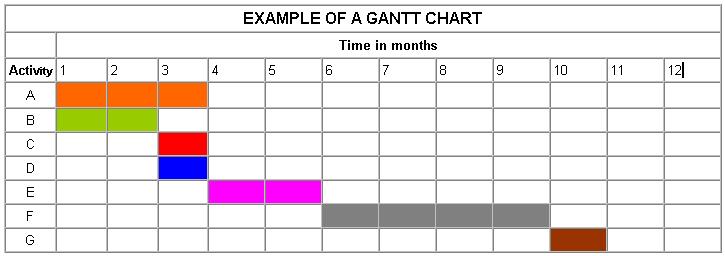
In order to produce the objectives, we have to undertake a number of activities. We are now focusing on the "how" of the project, having completed the "what" (the objectives and performance indicators). The activities included in the project design should be target-oriented in that they are tasks to be performed in order to produce a specified project output. If the task is not geared to producing one of the outputs, it should not be listed as a project activity.
Generating a list of activities is a fairly disciplined exercise. We use the conceptual model and the list of objectives to develop activities. The conceptual model already defines some of the main things that should be in place, and the objectives further refine the model. Write all the activities down and check to see if the list is comprehensive, and then check to see if there are any redundant or unnecessary activities on the list. Once the list is generated, it is useful to cluster activities that are closely related in order to identify key activities.
These activities should be listed on an activity chart in a sequential manner – what happens first then second and so on. The next step is to find the “depends on” activities for every activity in the list. Some activities are not dependent on the completion of other activities in order to start, whereas others require another activity to be completed before starting the new activity. The next step is to make some rough assessment of the duration of each activity. How long would it take from start to completion time to do the activity? Use a standard time unit for all the activities e.g. days, weeks, months or years. Write the duration for every activity down on the activity chart.
At this point you can see the similarity between the process and even the steps in project management and that involved in your 4-Step Project: we have just arrived at the methods (specifically the measurements) having set Aims and Objectives.
| EXAMPLE OF AN ACTIVITY CHART | ||||
|---|---|---|---|---|
| Activity | Description | Starting date (depends on activity) | Duration (weeks) | Earliest starting time |
| A | Buy land | - | 12 | 0 |
| B | Design building | - | 8 | 0 |
| C | Calculate cost of materials | B | 4 | 8 |
| D | Draw up tender | B | 4 | 8 |
| E | Contract builder | C | 8 | 12 |
| F | Build clinic | E | 16 | 20 |
| G | Furnish clinic | F | 4 | 36 |
The Gantt chart is simply a way of presenting the final plan as developed on the activity chart. The vertical axis of the Gantt chart indicates the different activities as developed on the activity chart. The horizontal axis represents time (in standardised units as developed on the activity chart). For each activity fill in the amount of time required to complete the activity. Be aware of starting times - especially when the start of one activity is dependent upon first completing another activity. The Gantt chart is a useful tool to schedule activities and monitor the project implementation process.

Complete the Earliest starting times in the table below then draw up a GANTT chart using the following information:
| Activity | Starting date (depends on activity) | Duration (weeks) | Earliest starting time |
|---|---|---|---|
| A | Identify peer workplace trainers | - | 2 |
| B | Undertake survey in workplace to identify level of knowledge | - | 2 |
| C | Develop training materials | B | 4 |
| D | Identify suitable training date and arrange venue | C | 1 |
| E | Undertake training | D | 1 |
| F | Develop training evaluation programme | B | 1 |